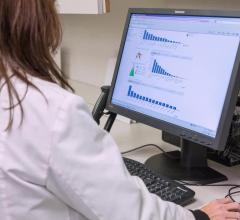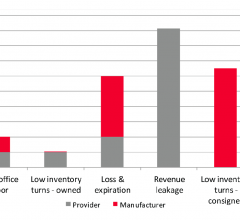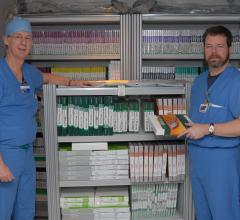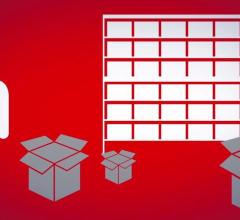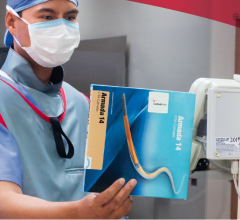
Staff can call up an RFID tracking system map of a hospital floor to locate RFID/RTLS tagged equipment or see the location of patients or staff.
Clinicians spend a lot of time walking around hospitals looking for equipment, other staff members, and sometimes even their patients. However, hospitals are finding the use of real-time locating systems (RTLS) can immediately improve staff efficiency, save money by cutting down on purchases of extra equipment, and aid infection control, track patients through surgery, and help meet HIPAA requirements by automatically logging staff on and off of computers.
There are several technologies for RTLS tracking that use active and passive radio-frequency (RFID), ultrasound or infrared emitting “tags.” The tags are small plastic boxes ranging in sizes from a large wristwatch or small cell phone. The tags can either be attached to a piece of equipment, worn as an ID badge, or worn on a patient’s wristband.
These systems can help with asset tracking, process automation, improving operational efficiency, increasing patient flow, enhancing patient safety, theft prevention, and locating equipment quickly for maintenance, upgrades and during recalls.
Tracking information can also can be reviewed and used to improve hospital business processes and asset utilization, reduce capital expense and rental costs, and improve staff productivity.
RFID Systems
RFID systems detect radio frequencies emitted by the tags using a WiFi network. The advantage of RFID is it can usually operate on exisiting hospital 802.11 WiFi infrastructure. Most RFID systems use software that takes detection data for the same tag from several detectors to triangulate the tag’s position in relation to the detectors and the tag’s received signal strength.
While RFID is designed to work on existing WiFi networks, some experts say the requirements of sensor data collection may sometimes conflict with the original design of a WiFi system and overload it.
One of the leaders in the RFID field is AeroScout, which has partnered with numerous companies, including Philips. Its WiFi-based active RFID tags and/or standard WiFi devices send a wireless signal (chirp) at a regular interval. The signal is detected by standard wireless access points (or AeroScout location receivers), and is sent to a location processing engine. It sends this data to AeroScout MobileView to display the location on maps and enable searches.
Time Domain Corp.’s Precision Location Ultra Wideband System (PLUS) claims to read thousands of RFID tags per second through multiple walls with a precision of 12-36 inches. The company says the tags emit a 6.4 GHz ultra wideband burst of extremely short pulses once a second which, when read and processed by a time difference of arrival algorithm, provides inches of accuracy multi-floor environments. Time Domain said this short pulse approach also provides precise location accuracy in “noisy” indoor environments where wiring and metal fixtures are often problematic for other RFID systems.
AeroScout has partnered with Time Domain to produce its Ultra-WiFi line of products released in February, enabling tracking tags using both WiFi and ultra wideband detection at the same time. This reportedly increases accuracy within 12 inches.
Awarepoint has developed an RFID system that uses ZigBee-enabled sensors that are plugged into standard wall outlets. ZigBee’s design helps avoid collision of signals to prevent interference such as “floor hopping,” which can be an issue with WiFi when detectors from another floor detect a tag’s signal.
“The Awarepoint system is super easy to use,” said Robert Pruett, supervisor, clinical engineering services, laboratory equipment repair specialists, University of California - San Diego, Thornton Hospital and La Jolla Campus, La Jolla, CA. “We were up and running in about a week,”
The hospital adopted Awarepoint’s system three years ago and now monitors about 400 pieces of equipment. These assets include infusion pumps, coagulators, electro-surgical generators, video carts in the ORs, patient anesthetic pumps, microscopes, and even smaller devices which might be missed by a clinician if it is on a shelf, like colonoscopy scopes.
Thornton wanted to use RFID to assist staff with finding equipment, maintain a more accurate equipment inventory, manage capital and equipment purchases, preventative maintenance, track equipment utilization, and manage theft and misplaced equipment.
“It helps with efficiency immediately and your payback with the system is the increased efficiency,” Pruett said, noting staff now just look at a screen to see where equipment is located instead of searching all over the hospital.
A more accurate inventory of machines such as wheelchairs and infusion pumps and the ability to find them has also lead to fewer new purchases.
“The bigger the institution the more benefit you will get from RFID,” Pruett said. “The bigger the facility there are just more nooks and crannies to hide things.”
One glitch Pruett said commonly occurs with the RFID system is that tags can accidentally be turned off by their on/off switch if they are bumped or pushed when the equipment is being moved. Another issue is the detectors sometimes misjudging the location of a tag, making it appear to be in the room next door. Pruett said Awarepoint’s accuracy is in a radius of about 7-12 feet. He said this has not been a major issue, because staff know if they can’t find a piece of equipment in the room indicated, it is likely on the other side of the wall in the next room. Regardless of this glitch, he said staff efficiency has greatly increased.
RFID systems can sometimes show the location of items on a floor above or below where it is actually located. Thornton Hospital’s design helped solve this problem by using RFID on alternating floors, because it has offices and non-medical floors in between its patient floors.
Ultrasound RTLS
To avoid the issues presented by RFID, Sonitor Technologies has developed a system that uses ultrasound waves instead of radio waves. The high frequency sound does not penetrate floors, walls and ceilings like RFID, but it does require a detector in every room being monitored.
Seton Medical Center, a 541-bed hospital in Austin, TX, is one of Sonitor’s biggest installations, with about 3,000 pieces of equipment now being tracked.
Jeffrey Falwell, PMP, IS PMO Manager, project manager for Seton, said the hospital began looking in 2004 for an RFID tracking system so it could keep track of highly mobile, expensive and in demand items such as infusion pumps and wheel chairs. He said the review committee received piles of information from RFID manufacturers and it was very tedious to sift through.
“The only one that was room-level accurate was Sonitor,” Falwell said.
He said the RFID systems could be tuned for pretty good room level accuracy, but changes in the electromagnetic field, such as pipe in the walls, the thickness of walls, and even metal food carts affect the nature of radio waves.
“When you move a metal food cart down the hall it will change your signal strength profile,” Falwell said.
In testing he said a cart caused one ID tag to appear 20 feet further away than it was prior to the cart being placed nearby.
“There is a lot of tuning needed to get it (RFID) accurate,” he said.
Falwell ultrasound waves do not penetrate walls or floors so room level accuracy was much easier to attain.
Tags placed under blankets, as frequently happens with patient tags, can still be detected, although Falwell said the sound is muffled and may appear to be further from a detector than it really is.
The detectors for ultrasound are basically high-fidelity microphones. The detectors are mounted on the wall and are about the size of two decks of cards, Falwell said.
The only issue Seton has found with ultrasound system is the acoustics of hallways sometimes causes issues with wall-mounted detectors accurately showing the position of a tag between two facing detectors.
Infrared RTLS
Centrak’s Dueltrak RFID technology uses a combination of radio frequency and infrared for more accurate locating. It uses a nonline-of-sight infrared technology than can detect tags even when they are under a patient’s blanket. The infrared signal cannot penetrate walls, allowing for room level accuracy. The company also offers “virtual walls” that can split a room into zones so detectors can be installed over each bed for bed-level accuracy.
“The ability to create ‘virtual walls’ in the often wide open environment of the emergency department, will enable us to quickly and reliably locate both patients as well as life-saving equipment such as cardiac defibrillators and portable ultrasound machines,” said Kenneth N. Sable, M.D., FACEP, director, division of informatics, emergency department, Maimonides Medical Center, Brooklyn, NY. “Additionally, this product is battery powered and requires no additional wiring, making it an extremely low maintenance solution.”
Centrak’s patient tags have a reusable case that can be sterilized, or worn in the shower.
GE Healthcare partners with Centrak to offer its RTLS system with GE’s equipment and hospital systems.
Deploying detectors
There are several ways an RFID/RTLS can be deployed. While all systems require asset tags to be attached to devices or worn by staff or patients, the detection devices to receive the chirps from tags varies. Most use ceiling or wall mounted detectors. Time Domain makes detectors that drop in as replacement ceiling tiles. These solutions require the detectors to be hardwired. Fixed RFID detectors also need to be placed by an engineer who can evaluate the best location for maximum coverage with a minimal amount of units.
Some manufacturers also provide “plug and play” type systems that minimize setup time and installation costs. These systems can be up and running in a matter of hours. These detectors need to be installed in every room and common area where RTLS is needed. Awarepoint and RadarFind both use detectors that plug into existing wall sockets. Centrak uses wall or ceiling mounted, D-cell battery powered detectors that are the size as home smoke detectors.
Tag battery life
RTLS tags all use batteries to transmit a “chirp” signal to announce its location. These are in turn picked up by the detectors and displayed on a computerized map. The frequency of the chirps is a big factor in determining battery life. For example, Centrak tags are set to chirp every 30 seconds, which the company says gives its tags a battery life of about five years. Different systems use tags set to chirp between 5 seconds up to every 10 minutes. Tags can be configured to chirp only when they are being moved, or less frequently when stationary. The more chirps emitted, the shorter the battery life.
Tracking patients in the OR
Several companies offer RTLS systems to track patients through the perioperative process. The systems are designed to boost patient safety, patient identification, surgical information verification, allow families to track their family member’s progress, and to help hospitals increase efficiency and identify workflow issues.
InfoLogix launch its SurgiChip verification system this past spring. The system uses RFID technology in an automated, controlled process to accurately identify and document that a surgical team performs the proper procedure on the correct patient at the right surgical site prior to the start of a procedure. It provides an electronic audit trail to verify compliance with the Joint Commission’s Universal Protocol.
PeriOptimum’s PathFinder offers an RFID system that tracks patients throughout the perioperative process. It instantly communicates the status and location of a surgical patient to medical staff, administrators and family members in real time, which can be viewed on a tracking screen in the waiting room without family members having to track down a nurse or make several calls to the surgical department. The system cut phone calls to the surgical department at Mississippi Baptist Medical Center by 60 percent since implementing in 2004.
“It has really helped on communications and in reducing the phone calls,” said Kempf Poole, FACHE, director of surgical services, Mississippi Baptist Health in Jackson. “It has reduced phone calls immensely,”
The system allows families to leave the waiting room to visit the cafeteria or gift shop. They can check the status of their family member using a number code to unlock location information specific to a patient using a computer kiosk in the secondary waiting room or the cafeteria.
“In addition tracking the physical location of a patient, the RFID tags have a button on them that staff can push to signify a procedure has been done at a particular stage of the perioperative process. Kempf said this can include things such as administration of prophylactic antibiotics before entering the OR, or the first incision has been made when in the OR. In addition, other information can be added manually to the patient’s tracking information that only clinicians can see, such as lab values.
“I know it has helped improve patient safety because it has dramatically improved hand-offs,” Kempf said.
He said staff members receiving patients can immediately track their progress, have access to the most up to date information, and find a patient using the system.
In addition, the hospital used its PeriOptimum RFID system to analyze throughput, optimize scheduling and increase OR capacity by identifying bottlenecks. It also helped prevent issues with staff members arriving late or waiting around for another procedure to be completed. The information can also be tailored to find specific information on particular staff members or particular operating rooms.
Patient Care Technology Systems’ offers a similar system with its Amelior ORTracker version 2.6, which relies on RTLS technology.
Thornton Hospital tracked surgical patients through the perioperative process using a system from Awarepoint, but it was not as useful as originally envisioned and was discontinued.
“It’s an extra bell and whistle, but it’s just something else to keep track of,” Pruett said.
Helping with infection control
RadarFind’s RTLS system provides information about a device’s status and location history, which can assist a hospital’s infection control and surveillance. When a staff member moves a slider switch to indicate that a medical device is available, in-use or needs cleaning, the tag communicates this information to the RadarFind server, which displays that piece of equipment as green (available), yellow (in use with a patient) or red (needs cleaning) on RadarFind’s locator maps. The tags themselves include a color-coded bar so staff have a visual cue to quickly determine if the equipment is disinfected.
This system is being used by Halifax Regional Medical Center in northeastern North Carolina.
“By being able to identify equipment we can insure that only clean, processed equipment is ever brought into a patient room,” explained Vice President of Nursing Karen Daniels, RN, at HRMC. “Equipment used in an isolation room also can be clearly identified and properly decontaminated before being moved from isolation.”
Resurgent Health and Medical recently introduced its new CleanTech IC hand washing system, which incorporates RFID monitoring to ensure staff hand hygiene compliance. The system uses rotating cylinders that provide a high pressure, low volume water spray and cleaning solution. It reads the staff member’s RFID tag for compliance verification.
Identifying staff
RTLS tags worn by staff aids in finding them quickly, but the tags can also be used to meet HIPPA compliance by automatically logging staff in and out of secure computers as they walk up to them or walk away.
Ensure Technologies’ XyLoc utilizes an employee RFID tag to automatically recognize and authenticate users as they approach a PC and secures it as they walk away. The RF detector plugs into a USB port on the computer. The company partners with several healthcare companies, including Epic Systems, Key Source International (KSI) and Cerner.
Sonitor also has flash drive sized ultrasound detectors than can be plugged into a USB port on a computer to allow automatic logging in and logging out of staff members. Sonitor’s detectors can also be built into the computers.
July 2008



 April 28, 2017
April 28, 2017 
